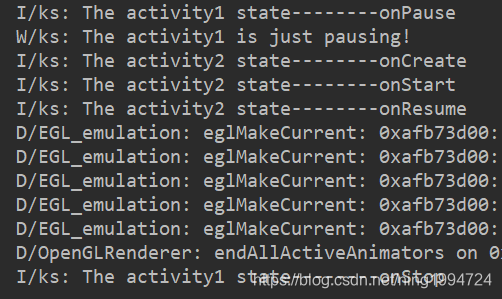android中Activity生命週期的詳細過程分析
android中Activity生命週期的詳細過程分析
Activity是安卓中相當重要的一個元件,理解它有利於我們後期更好的進行相關的開發,接下來我將演示一個demo來詳細講述Activity的生命週期過程。
首先寫兩個佈局檔案ks.xml和ks1.xml,用來實現兩個介面的跳轉,上面寫上簡單的button,程式碼如下:
ks.xml:
<RelativeLayout android:layout_width="match_parent" android:layout_height="45dp" android:background="@android:color/holo_red_light" android:gravity="center_vertical"> <ImageView android:id="@+id/search" android:layout_width="45dp" android:layout_height="45dp" android:src="@drawable/title_city" /> <ImageView android:id="@+id/division" android:layout_width="1dp" android:layout_height="40dp" android:layout_toRightOf="@+id/search" android:background="@android:color/white"/> <Button android:id="@+id/btn1" android:layout_width="wrap_content" android:layout_height="wrap_content" android:text="跳轉"/> </RelativeLayout>
ks1.xml:
<?xml version="1.0" encoding="utf-8"?>除了佈局檔案,當然還有兩個Activity,用於控制兩個介面的跳轉,Activity的幾個重要方法也在這裡面體現。<TextView android:id="@+id/afterlogin" android:layout_width="wrap_content" android:layout_height="80dp" android:layout_gravity="center" android:layout_marginBottom="30dp" android:layout_marginTop="50dp" android:textSize="30dp" android:textColor="#000000"/> <Button android:id="@+id/btn2" android:layout_width="wrap_content" android:layout_height="wrap_content" android:text="返回"/>
Activity1:
public class Activity1 extends Activity {
private static final String TAG = “ks”;
private Button btn;
@Override protected void onCreate(Bundle saveInstanceState) { super.onCreate(saveInstanceState); Log.i(TAG, "The activity1 state--------onCreate"); setContentView(R.layout.ks); btn = (Button) findViewById(R.id.btn1); btn.setOnClickListener(new View.OnClickListener() { @Override public void onClick(View view) { Intent i = new Intent(Activity1.this, Activity2.class); startActivity(i); } }); } protected void onStart() { super.onStart(); Log.i(TAG, "The activity1 state--------onStart"); } protected void onRestart() { super.onRestart(); Log.i(TAG, "The activity1 state--------onRestart"); } //重新開始 protected void onResume() { super.onResume(); Log.i(TAG, "The activity1 state--------onResume"); } protected void onPause() { super.onPause(); Log.i(TAG, "The activity1 state--------onPause"); if (isFinishing()) { Log.w(TAG, "The activity1 will be destroyed!"); } else { Log.w(TAG, "The activity1 is just pausing!"); } } protected void onStop() { super.onStop(); Log.i(TAG, "The activity1 state--------onStop"); } protected void onDestroy() { super.onDestroy(); Log.i(TAG, "The activity1 state--------onDestory"); }
}
Activity2的程式碼:
public class Activity2 extends Activity {
private Button btn2;
private static final String TAG = “ks”;
@Override
protected void onCreate(Bundle savedInstanceState) {
super.onCreate(savedInstanceState);
Log.i(TAG, "The activity2 state--------onCreate");
setContentView(R.layout.ks1);
btn2 = (Button) findViewById(R.id.btn2);
btn2.setOnClickListener(new View.OnClickListener() {
@Override
public void onClick(View view) {
Intent i = new Intent(Activity2.this, Activity1.class);
startActivity(i);
}
});
}
protected void onStart() {
super.onStart();
Log.i(TAG, "The activity2 state--------onStart");
}
protected void onRestart() {
super.onRestart();
Log.i(TAG, "The activity2 state--------onRestart");
}
//重新開始
protected void onResume() {
super.onResume();
Log.i(TAG, "The activity2 state--------onResume");
}
protected void onPause() {
super.onPause();
Log.i(TAG, "The activity2 state--------onPause");
if (isFinishing()) {
Log.w(TAG, "The activity2 will be destroyed!");
} else {
Log.w(TAG, "The activity2 is just pausing!");
}
}
protected void onStop() {
super.onStop();
Log.i(TAG, "The activity2 state--------onStop");
}
protected void onDestroy() {
super.onDestroy();
Log.i(TAG, "The activity2 state--------onDestory");
}
}
下面是執行過程的分析:
當啟動activity1時候,activity1所對應的ks.xml介面開啟

可見啟動介面後,依次執行onCreate,onStart,onResume,
點選跳轉button,介面走到ks1.xml
此時的列印順序為

我們再點返回button,重新回到第一個介面,此時的執行順序為
可見,和之前類似,activity2先暫停,activity1再次被建立,進入activity1介面,activity2stop,如此反覆迴圈。
我們發現,這裡並沒有出現activity被銷燬的情況,即並沒有打印出onDestroy的方法。
如果只是在兩個button上相互跳轉,兩個activity只會stop,只有當按下模擬機中的back鍵時候,某一個activity會被銷燬。



